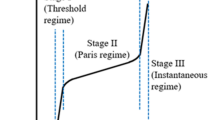Abstract
During the fabrication of large structures, proper consideration of the mean stress due to locked-in stress is very important to quality control. In general, crack propagation life is shortened when applying the tensile mean stress. In this study, we examine the mean stress effect in terms of the fatigue crack growth rate (FCGR). We propose a FCGR model that considers crack closure, partial crack closure and compressive loads. The proposed model is validated with aluminum 5083 as well as three other materials at various stress ratios, and is compared with other existing FCGR models. We show that the proposed model effectively characterizes the FCGR under various stress ratios into a single line.

















Similar content being viewed by others
References
ASTM E647–13. (2013). Standard test method for measurement of fatigue crack growth rates. West Conshohocken: American Society for Testing and Materials.
Boyce, B. L., & Ritchie, R. O. (2001). Effect of load ratio and maximum stress intensity on the fatigue threshold in Ti–6Al–4V. Engineering Fracture Mechanics, 68(2), 129–147.
Elber, W. (1971). The significance of fatigue crack closure. In Damage tolerance in aircraft structures. ASTM STP 486, USA.
Huang, X., & Moan, T. (2007). Improved modeling of the effect of R-ratio on crack growth rate. International Journal of Fatigue, 29(4), 591–602.
Kujawski, D. (2001a). Enhanced model of partial crack closure for correlation of R-ratio effects in aluminum alloys. International Journal of Fatigue, 23(2), 95–102.
Kujawski, D. (2001b). A new (ΔK + Kmax)0.5 driving force parameter for crack growth in aluminum alloys. International Journal of Fatigue, 23(8), 733–740.
Kujawski, D. (2001c). A fatigue crack driving force parameter with load ratio effects. International Journal of Fatigue, 23(1), 239–246.
Mann, T. (2007). The influence of mean stress on fatigue crack propagation in aluminium alloy. International Journal of Fatigue, 29(8), 1393–1401.
Mehrzadi, M., & Taheri, F. (2012). The influence of negative and positive stress ratios on crack growth rate in AM60B magnesium alloy. Materials Science and Engineering A, 545, 68–77.
Mehrzadi, M., & Taheri, F. (2013). Influence of compressive cyclic loading on crack propagation in AM60B magnesium alloy under random and constant amplitude cyclic loadings. Engineering Fracture Mechanics, 99, 1–17.
Paris, P. C., & Erdogan, F. (1963). A critical analysis of crack propagation laws. Journal of Basic Engineering, 85(4), 528–533.
Paris, P. C., Tada, H., & Donald, J. K. (1999). Service load fatigue damage—a historical perspective. International Journal of Fatigue, 21(1), S35–S46.
Schmidt, R. A., & Paris, P. C. (1973). Threshold for fatigue crack propagation and the effects of load ratio and frequency. ASTM STP 536, USA.
Shabanov, A. P. (2005). Mechanism of fatigue crack growth under compressive external stresses. J Appl Mech Tech Phy, 46(6), 861–866.
Silva, F. S. (2005). The importance of compressive stress on fatigue crack propagation rate. International Journal of Fatigue, 27(10), 1441–1452.
Walker, K. (1970). The effect of stress ratio during crack propagation and fatigue for 2024-T3 and 7075-T6 aluminum. ASTM STP 462, USA.
Yamada, Y., & Newman, J. C., Jr. (2009). Crack-closure behavior of 2324-T39 aluminum alloy near-threshold conditions for high load ratio and constant Kmax tests. International Journal of Fatigue, 31(11–12), 1780–1787.
Zhu, M. L., Xuan, F. Z., & Tu, S. T. (2013). Interpreting load ratio dependence of near-threshold fatigue crack growth by a new crack closure model. Int J Press Vessel Pip, 110, 9–13.
Acknowledgements
This work was supported by the National Research Foundation of Korea (NRF) grant funded by the Ministry of Science, ICT and Future Planning (MSIP) of the Korea government through GCRC-SOP (No. 2011-0030013). This work was also supported by the Human Resource Training Program for Regional Innovation and Creativity through the Ministry of Education and National Research Foundation of Korea (No. NRF-2014H1C1A1073088). The authors gratefully acknowledge this support.
Author information
Authors and Affiliations
Corresponding author
Rights and permissions
About this article
Cite this article
Choi, Y., Oh, D.J., Lee, J.M. et al. A New Model of Fatigue Crack Growth Rate Considering Mean Stress Effects Due to Locked-In Stress. Int J Steel Struct 19, 1099–1111 (2019). https://doi.org/10.1007/s13296-018-0190-z
Received:
Accepted:
Published:
Issue Date:
DOI: https://doi.org/10.1007/s13296-018-0190-z



